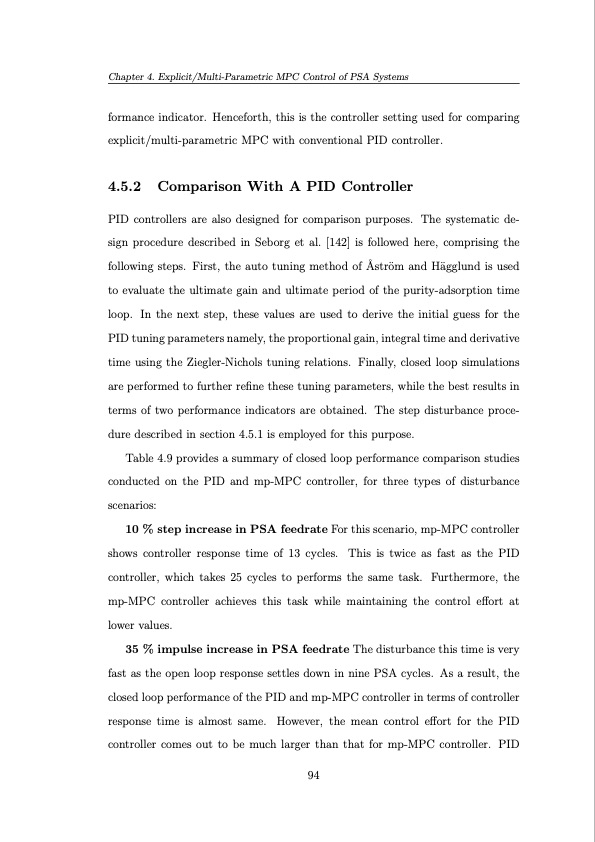
PDF Publication Title:
Text from PDF Page: 094
Chapter 4. Explicit/Multi-Parametric MPC Control of PSA Systems formance indicator. Henceforth, this is the controller setting used for comparing explicit/multi-parametric MPC with conventional PID controller. 4.5.2 Comparison With A PID Controller PID controllers are also designed for comparison purposes. The systematic de- sign procedure described in Seborg et al. [142] is followed here, comprising the following steps. First, the auto tuning method of ̊Astr ̈om and H ̈agglund is used to evaluate the ultimate gain and ultimate period of the purity-adsorption time loop. In the next step, these values are used to derive the initial guess for the PID tuning parameters namely, the proportional gain, integral time and derivative time using the Ziegler-Nichols tuning relations. Finally, closed loop simulations are performed to further refine these tuning parameters, while the best results in terms of two performance indicators are obtained. The step disturbance proce- dure described in section 4.5.1 is employed for this purpose. Table 4.9 provides a summary of closed loop performance comparison studies conducted on the PID and mp-MPC controller, for three types of disturbance scenarios: 10 % step increase in PSA feedrate For this scenario, mp-MPC controller shows controller response time of 13 cycles. This is twice as fast as the PID controller, which takes 25 cycles to performs the same task. Furthermore, the mp-MPC controller achieves this task while maintaining the control effort at lower values. 35 % impulse increase in PSA feedrate The disturbance this time is very fast as the open loop response settles down in nine PSA cycles. As a result, the closed loop performance of the PID and mp-MPC controller in terms of controller response time is almost same. However, the mean control effort for the PID controller comes out to be much larger than that for mp-MPC controller. PID 94PDF Image | Operation and Control of Pressure Swing Adsorption Systems

PDF Search Title:
Operation and Control of Pressure Swing Adsorption SystemsOriginal File Name Searched:
Khajuria-H-2011-PhD-Thesis.pdfDIY PDF Search: Google It | Yahoo | Bing
CO2 Organic Rankine Cycle Experimenter Platform The supercritical CO2 phase change system is both a heat pump and organic rankine cycle which can be used for those purposes and as a supercritical extractor for advanced subcritical and supercritical extraction technology. Uses include producing nanoparticles, precious metal CO2 extraction, lithium battery recycling, and other applications... More Info
Heat Pumps CO2 ORC Heat Pump System Platform More Info
| CONTACT TEL: 608-238-6001 Email: greg@infinityturbine.com | RSS | AMP |